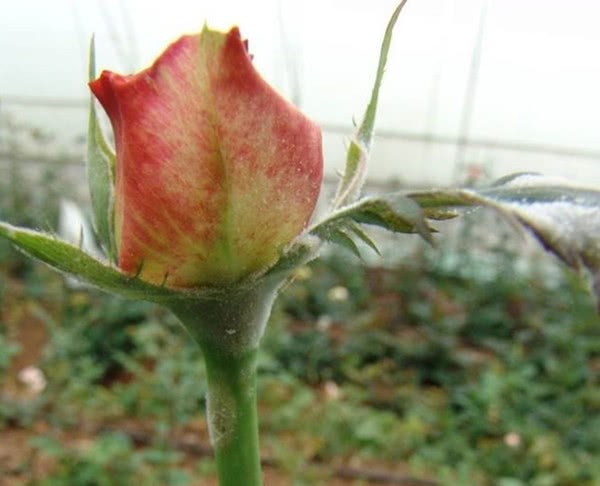Common diseases and insect pests of rose and their control methods

Rose originated in China and spread abroad as early as 200 years ago. after long-term cross breeding by horticulturists in Europe and the United States, modern rose has developed to more than 20,000 varieties. Rose is hardy, adaptable and suitable for both ground and potted plants, so it is widely planted all over the world. Several diseases and insect pests occurred in rose and their control methods are introduced one by one.
1. Powdery mildew
Symptoms: starting from the upper middle, the leaves, buds and tender occur slightly. In the early stage, chlorotic macula appeared on the leaves, gradually enlarged, and white powdery mildew spots appeared, followed by a layer of white powder, and in severe cases, all the young leaves were curled, wrinkled, thickened, and sometimes purplish red. Petiole and tender slightly infected when inflated, the opposite curved, the young leaves can not expand. The old leaves have round or irregular powdery spots, but the leaves are not twisted.
Control method: spray with 3000 times of 50% Cuibei dry suspension and 3000 times of 25% tebuconazole EC on both sides of the plant.
2. Grey mold
Symptoms: the pathogen is Botrytis cinerea. The pathogenic fungus infects the flower, bud and tender stem of rose, and the disease spot mainly occurs on the flower. At first, it was waterlogged irregular spot, slightly sunken, and then became brown and rotten. The disease on the bud also produces waterlogged irregular spots, which can be extended to the whole bud, and finally the whole bud becomes soft and rotten. The diseased buds withered and hung over or near the diseased tissue. In a warm and humid environment, the disease can produce a large number of gray mildew layer.
Prevention and treatment: it is not suitable to use litter to protect the root in autumn, so as to avoid excessive dampness at the base of the stem, which is conducive to the survival of bacteria. In greenhouse cultivation, we should pay attention to ventilation and light transmission, avoid excessive humidity, prevent spray watering, not partial application of nitrogen fertilizer, not excessive close planting. The infected flowers should be removed and the diseased buds should be cut off and destroyed together with the stem a few centimeters below the bud.
3. Downy mildew
Symptoms: irregular light green markings appear on leaves, new leaves and flowers, then expand and show yellowish brown and dark purple, finally grayish brown, the edge is dark, gradually expand and spread to healthy tissue, there is no obvious boundary, moist air, sparse gray-white downy mildew layer can be seen on the back of diseased leaves, leaves are easy to fall off, axillary buds and pedicels are deformed, disease spots appear, and cracks appear at the base when severe. It withered down along the incision, and some of the disease spots were purplish red and gray-white in the middle core. when the disease spot was slightly infected with flowers, the disease spot was similar to the diseased leaf, the disease spot was slightly sunken, and when it was serious, the leaf wilted and fell off, and the new leaf was slightly rotten and withered.
Prevention and control methods: reducing the humidity at night is the key to prevention and treatment, alternately using polyoxomycin, metalaxyl and aluminum triethylphosphonate aerosol, once every 2-7 days, or 1000 times the liquid spray of 70% methyl thiophanate wettable powder.
4. Black spot
Symptoms: the pathogen is Disporium roseum. The pathogenic fungus mainly infects the leaves of rose and can also invade petioles and tender shoots. In the early stage of the disease, brown dots first appeared on the front of the leaves, and gradually expanded into nearly round or irregular plaques, with a diameter of 4 to 12 mm, black and purple, with a radial edge and a yellow halo. In the later stage, the central tissue of the lesion turned gray, and there were many black dots on it, and the black blister-like microsomes could be seen under the magnifying glass, which was the conidial disk of the pathogen. The disease spots are connected to each other so that the leaves turn yellow and fall off (some rose varieties do not shed the diseased leaves). Black striped spots appear on young branches and pedicels, slightly concave. In severe cases, all the middle and lower leaves of the plant fall off, leaving only a few leaves at the top.
Control methods: thoroughly remove the dead branches and leaves at the end of autumn, prune and destroy the diseased branches in combination with winter pruning. Spraying 2000 times pentachlorophenol sodium solution or 1% equivalent Bordeaux solution during dormancy killed the overwintering bacteria on the disease residue.
- Prev

Zhu Dinghong, who blossoms three times a year, reluctantly tells the truth.
A flower friend's double scarlet red is very beautiful, and then can not help but ask him about the maintenance skills, everyone knows that Zhu Dinghong usually blossoms only once a year in summer, but this flower friend's Zhu Dinghong can open three times a year, let people in.
- Next

Intoxicated with the road covered with little flowers.
An insignificant flower, although beautiful, it is easy to be ignored. However, the bushes of flowers paved with the road are heart-shaking and fragrant. ...
Related
- Wuhan Hospital Iron Tree Blooming Result Was Instantly Frightened by the Gardener Master
- Which variety of camellia is the most fragrant and best? Which one do you like best?
- What is the small blue coat, the breeding methods and matters needing attention of the succulent plant
- Dormancy time and maintenance management of succulent plants during dormancy
- Minas succulent how to raise, Minas succulent plant pictures
- What are the varieties of winter succulent plants
- How to raise succulent plants in twelve rolls? let's take a look at some experience of breeding twelve rolls.
- Attention should be paid to water control for succulent plants during dormant period (winter and summer)
- Watering experience of twelve rolls of succulent plants
- Techniques for fertilizing succulent plants. An article will let you know how to fertilize succulent plants.

